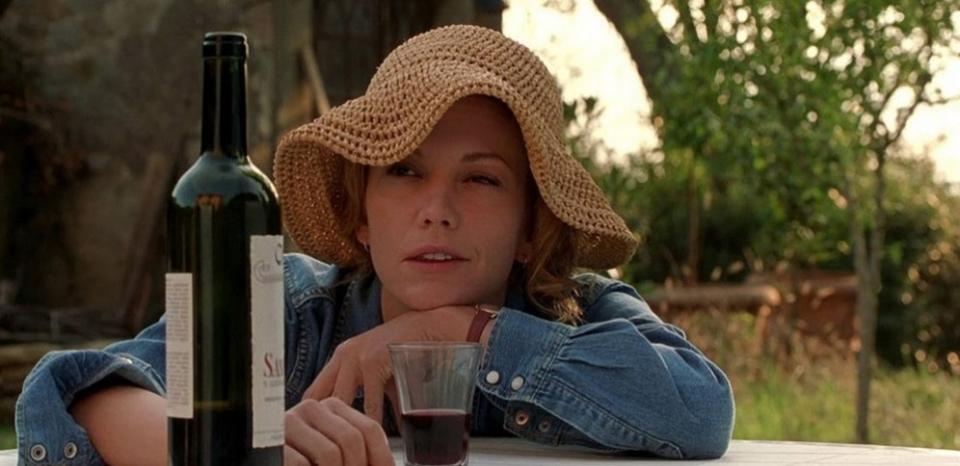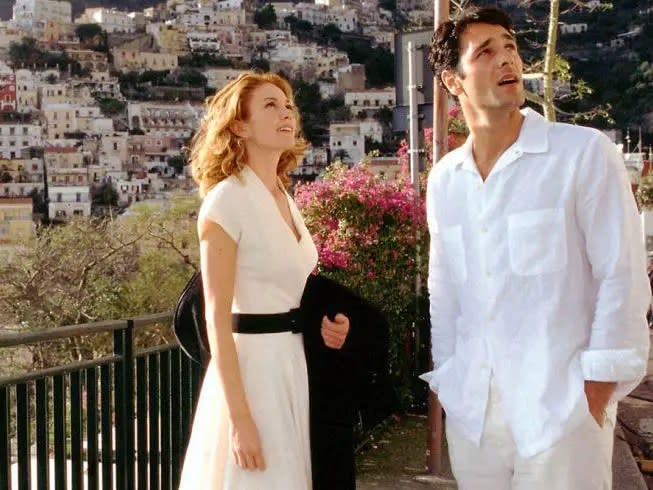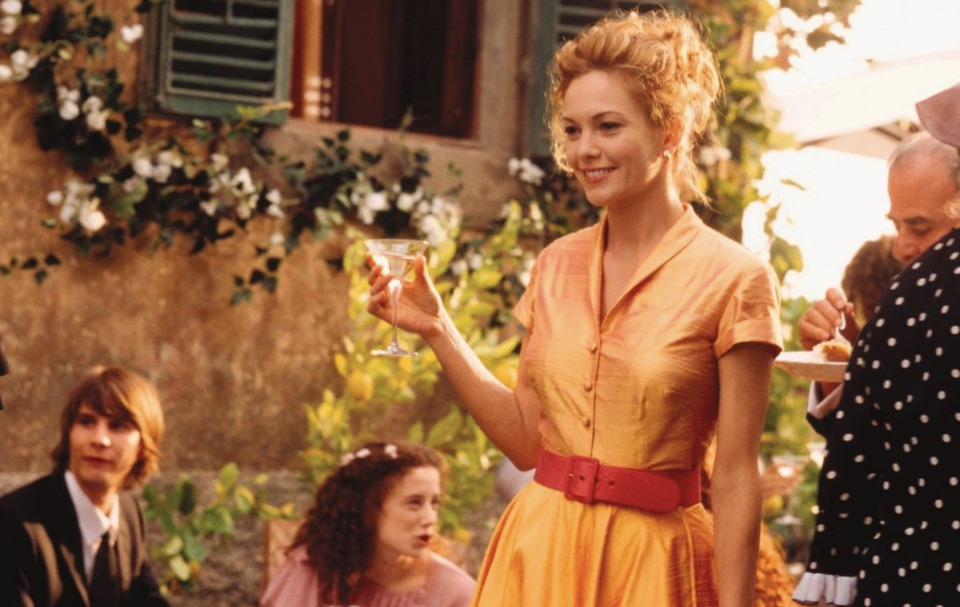The Iconic ‘Under the Tuscan Sun’ Yellow Dress Is Still Setting Trends 20 Years Later

- Oops!Something went wrong.Please try again later.
- Oops!Something went wrong.Please try again later.
- Oops!Something went wrong.Please try again later.
- Oops!Something went wrong.Please try again later.
Two decades ago, one jilted heart found its way to Italy as part of the iconic, genre-redefining film “Under the Tuscan Sun.” Starring Diane Lane as Frances, a San Francisco writer who jets to Europe after realizing her soon-to-be ex-husband is cheating on her, the 2003 film cemented the early aughts’ obsession with starting over again. “Under the Tuscan Sun” was based on a real-life Frances, author Frances Mayes to be exact, whose memoir was adapted by late writer-director Audrey Wells for the big screen.
Frances, newly jilted and with the emotional support of her best friend Patti (Sandra Oh), escapes both midlife crises and bad American men by traveling across the globe for a luxury vacation. She falls in love with a Tuscan villa and opts to renovate it while bonding with locals, including the seductive Marcello (Raoul Bova).
More from IndieWire
'The Monk and the Gun' Review: Bhutanese Villagers Welcome Democracy (and Daniel Craig) with Caution
“Under the Tuscan Sun” spurred the iconic vacation-in-a-movie feeling, kicking off an entire genre that grew to encompass “Eat, Pray, Love,” “Last Holiday,” “The Holiday,” “Leap Year,” “When in Rome,” “P.S. I Love You,” “Letters to Juliet,” and a slew of other 2000s films.
“Under the Tuscan Sun” grossed $58.9 million on an $18 million budget, making the Touchstone Pictures film bankable proof that a rom-com with naturally gorgeous scenery very much has an audience. Roger Ebert wrote for the Chicago Sun-Times that while the film was busy “seducing audiences with a shapely little villa in Italy,” its core message proved something deeper: “What redeems the film is its successful escapism, and Lane’s performance,” Ebert wrote at the time.
The history of how “Under the Tuscan Sun” got made in the first place has a highbrow link: The film was all due to the production of “The Talented Mr. Ripley,” the beloved 1999 psychological thriller based on Patricia Highsmith’s novel. Producer Tom Sternberg met “Under the Tuscan Sun” author Mayes while shooting in Siena and pitched the film adaptation of her memoir in 2000.
In celebration of the film’s 20th anniversary, IndieWire spoke with cinematographer Geoffrey Simpson and costume designer Nicoletta Ercole to unpack the legacy of how “Under the Tuscan Sun” became an ode to aspirational living.
A Twist of Fate and a Surprise ‘Round-the-Globe Trip
“Under the Tuscan Sun” was originally set to be lensed by another cinematographer before Geoffrey Simpson became involved with the project. “It was actually quite a long way down the track because [Audrey Wells] had a cinematographer whose partner had a health issue and he had to pull out. So the film was pretty well in place,” Simpson told IndieWire. “A lot of the cast was made. Tom Sternberg was one of the producers, and he’d worked on ‘The Talented Mr. Ripley’; a lot of the people that he’d worked with in Italy were from that film. But they hadn’t done any location work or anything like that, scouting or anything.”
So, what changed? “Oh, it’s quite a good story actually,” Simpson said. “My agent sent me the script and I read it and loved it and all that sort of stuff and then they wrote back and said, ‘Audrey Wells, a wonderful director, would like to have a telephone call.’ I spoke with Audrey and I said, ‘Audrey, I really get the feeling that you won’t be able to make up your mind unless you meet me in person.’ And she said, ‘Well, you’re very astute. That’s exactly what I’m thinking.’ So I said, ‘Look, I’ve got lots of frequent flyers. Why don’t I come to your place for dinner on Saturday night?’ That was in two days’ time. And that’s what I did.”
Simpson flew from Australia to Los Angeles for one dinner with Wells, producers, and select cast members, including Oh. And just like that, Simpson was bound for Tuscany.
‘A Dream Job‘
Costume designer Nicoletta Ercole immediately bonded on set with star Diane Lane, especially after realizing the two had known each other for decades.
“I was very happy to work with Diane Lane because we discovered that when I fly to L.A. to make the costume fitting, she said to me, ‘I know you, I think that we met each other.’ I discovered that she was an actress in an Italian-American movie that they shot in 1981 in Savannah Beach,” Ercole told IndieWire. “She said to me, ‘You dressed my mother and I came for the costume fitting there.’ She had a little role in ‘Tales of Ordinary Madness’ by an Italian director Marco Ferreri. And I said, ‘Oh, this little child, this little girl so nice. Why don’t we put her in the movie too?’ I talked with the director and the director said to me, ‘Yes, Nicoletta, if you can dress her.’ So Diane was an extra in the movie.”
Suddenly, Italy was crawling with “Under the Tuscan Sun” filmmakers: Simpson recalled not being able to go anywhere without running into another crew member.

“We just arrived in Rome, they booked me into a hotel and I had a day of wandering around in Rome and before flying to Cortona. I was sitting next to the production designer at a cafe during breakfast and everywhere we went, it was just stunningly beautiful. It was like a working vacation,” Simpson said. “It was a dream job. And the food, oh my God, the restaurants were going because food was such a big theme in the film that we went, ‘Well, we better test this restaurant, see what this is like.'”
Once production began, Simpson said that the cast and crew would watch the dailies together every night and walk through the streets of Cortona. “I had a really, really good Italian crew,” Simpson said, adding that Sandra Oh became a “really good friend” over the course of filming.
Italy Meets San Francisco Fashion
Ercole, hot off of working on Richard Loncraine’s HBO film “My House in Umbria,” was key to creating the American-in-Italy aesthetic, including tying in some local customs to Lane’s outfits, which Ercole made by hand.
“At the beginning, she was more American than European or Italian. But after a few days, she keeps something from the country women, something that is a mix between timeless style and maybe contemporary style,” Ercole said.
Ercole explained that each outfit was specifically tied to lines in the script to chart Frances’ evolution over the course of the film. It was also key to show how Frances’ attire stood out from her fellow characters, much like (almost) love interest Marcello, a native Italian.
“When you start to think about and study a script, I use my imagination to go inside the character, discover the psychology of the character, and you start to make sketches based on what they would look like,” Ercole said. “It’s so funny, because if you remember before the wedding scene, the scene when she goes to Positano? Raoul is obviously Italian and so he’s more put together than she is. An Italian man knows how to be handsome and it’s very sexy for me. He’s always dressed in white, lean and white. It’s see-through a little bit so you can see the shape of the shoulders, the back. I loved that scene in Positano because both of them were [in] white.”

And Ercole took the title of the film literally: Most of Frances’ looks incorporate some sort of sunset color. “I tried to come inside the American mentality but with a taste of an Italian because for instance, if an American comes to Italy. There is something that, you know, that you keep from this country that come inside you,” Ercole said.
Ercole pointed to Frances learning the laidback ways of Italian countryside living, including how to cook (and eat!) the cuisine, as markers for her clothing transformation onscreen, complete with nods to the sun setting on Frances’ romantic insecurities.
“Do you remember when she learned to cook in Italian style?” Ercole asked. “When you know, at the really end, the marriage, do you remember the wedding at the end with an orange top and the skirt that kind of ’50s style? I used orange because for me, it mirrored the the sun shining in the countryside and like the name and everything and the color of sunset. It all goes together.”
The Villa Inspired the Clothes
Ercole, who has been a costume designer for 50 years, sourced vintage pieces to make Frances’ housework looks seem more authentic. Ercole sought to have the restoration of the crumbling villa not only represent Frances’ emotionally but also physically when it came to her style.
“I went to a flea market and found very old overalls that maybe Frances found in leftover luggage when she moves in,” Ercole said, citing the background of the character. “We don’t know exactly who lived in that house, maybe some farmer. That’s why I mixed the overalls with a farmer’s shirt and the cowboy boots. The countrymen in Italy use bandanas for sweat in the sun; it’s very normal and very Italian to wear a bandana while working. That’s why I put the bandana on her too.”
“I try not to use contemporary fashion in my films because if you keep the style of the moment in a movie, it will become old very fast,” Ercole said. “So I hope if you can see the movie now that you really like to see the timeless style, that it can exist at any point. For instance, if you remember 10 years ago, all the jeans were low-waist. I never used that in a movie. I always use classic jeans.”

Yet one statement piece in the film found an intense American calling: Frances’ yellow dress.
“You can’t imagine how many times American women, ladies, you know, from Boston, from Texas, from, Arizona, from Florida, ask me to make the same dress for them for the marriage of the daughter or a party,” Ercole said. “It’s a great compliment for me.”
The Legacy of “Under the Tuscan Sun”
Writer-director Wells died in 2018. Costume designer Ercole recalled of working with her: “Audrey, I loved. She had a huge heart. It’s very sad because she was so young, so beautiful with a little baby.”
Cinematographer Simpson added, “Audrey, I really liked her as a person right from that first meeting and getting a hug and a kiss, you know, certainly sealed that relationship and we just became really good friends… She was terrific and had a good career, kept on working almost up until the last minute.”
Simpson continued with the American woman abroad rom-com genre, working on “Last Holiday” right after “Under the Tuscan Sun.” He noted that the film had a “bigger budget” than Wells’ feature, and included filming in locations like New Orleans and Austria. “It was a very lavish production,” he said.
Ercole similarly added to the genre with “Letters to Juliet,” in addition to Italian projects like “Gianni Schicchi” and “Uno per tutti.” Reflecting on the rise of Italy-set American productions ranging from “House of Gucci” to “Mafia Mamma” and “The White Lotus,” Ercole assured that if you’re in Italy, do as the Romans do…literally.
“There are a lot of American movies that have a ‘typical Italian’ cliché,” Ercole said. “So in this moment, it’s very convenient for productions to shoot in Italy because they have money back, you know, the tax credit, because I must tell you the truth: I don’t want to be superior but the Italians do it better. In terms of artistic departments, we are the best. The makeup, the hairstylists, and the costume designers, that’s why a lot of us work with Americans because in the end, we know the culture.”
Best of IndieWire
Where to Watch This Week's New Movies, from 'The Equalizer 3' to 'Perpetrator'
The Best Survival Movies, from ‘Cast Away’ and ‘The Revenant’ to ‘The Martian’ and ‘Alive’
Sign up for Indiewire's Newsletter. For the latest news, follow us on Facebook, Twitter, and Instagram.

